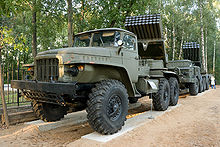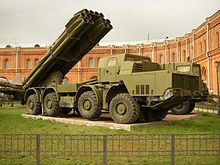- Multiple rocket launcher
-
"Multiple Launch Rocket System" redirects here. For the M270 Multiple Launch Rocket System, see M270 MLRS.
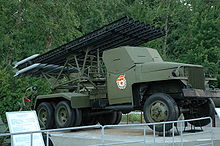 BM-13 Katyusha
BM-13 Katyusha
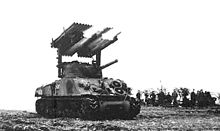 American T34 Calliope in action
American T34 Calliope in action
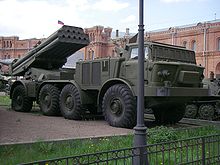 Launcher 9P140 of 220-mm multiple rocket launching system 9K57 BM-27 Uragan in Saint-Petersburg Artillery museum
Launcher 9P140 of 220-mm multiple rocket launching system 9K57 BM-27 Uragan in Saint-Petersburg Artillery museum
A multiple rocket launcher (MRL) is a type of unguided rocket artillery system. Like other rocket artillery, multiple rocket launchers are less accurate and have a much lower (sustained) rate of fire than batteries of traditional artillery guns. However, they have the capability of simultaneously dropping many hundreds of kilograms of explosive, with devastating effect.History
First developed in 1409, the Korean Hwacha is the most likely example of the first weapon system with a resemblance to the modern-day multiple rocket launcher. The first modern multiple rocket launcher was the German Nebelwerfer of the 1930s, a small towed artillery piece. Only later in World War II did the Allies deploy similar weapons in the form of the Land Mattress.
The first self-propelled multiple rocket launchers — and arguably the most famous — were the Soviet BM-13 Katyushas, first used during World War II and exported to Soviet allies afterwards. They were simple systems in which a rack of launch rails was mounted on the back of a truck. This set the template for modern multiple rocket launchers. The Americans mounted tubular launchers atop M4 Sherman tanks to create the T34 Calliope rocket launching tank, only used in small numbers, as their closest equivalent to the Katyusha.
See also
- Artillery rockets, in the list of artillery by type
- List of U.S. Army Rocket Launchers By Model Number
- M-87 Orkan
References

This artillery-related article is a stub. You can help Wikipedia by expanding it.

